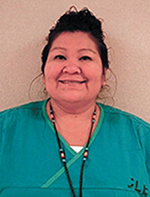Why did you choose your specific health professional career?
As a child, I wanted to be a nurse, but after volunteering at a local hospital I lost interest in nursing. On career day during my senior year in 1985, various schools came to my high school. One particular school talked about respiratory therapy which interested me, because it was diverse in that you treated patients of all ages.
 What experiences did you have to make sure this profession was right for you?
What experiences did you have to make sure this profession was right for you?
I changed my career choice as a result of my experience as a volunteer at a local hospital, where I actually saw what the duties of nurses and doctors were on a day to day basis. So, I suppose my experience of
volunteering at a hospital helped me to decide.
Describe any obstacles or barriers to success that you encountered along your health professional career path and how did you overcome them?
The major obstacle that I encountered was lack of finances. I came from a family with many financial challenges; therefore my parents were not able to assist me financially. I received a Pell Grant and got a student loan to pay for school.
What do you do in your current job?
I am a respiratory therapist. I work with patients of all ages and in many different care settings. Respiratory Therapists are members of the health care team that provide respiratory care for patients with heart and lung disorders. Most Respiratory therapists work in hospitals where they perform intensive care, critical care, and neonatal procedures. They are also typically a vital part of the hospital’s lifesaving response team that handles patient emergencies. Respiratory therapists perform procedures that are both diagnostic and therapeutic. Some of these activities include: Obtaining and analyzing sputum and breath specimens; obtain blood specimens and analyze them to determine levels of oxygen, carbon dioxide, and other gases and interpreting the data obtained from the specimens; measuring the capacity of lung function; studying disorders of people with disruptive sleep patterns; operating and maintaining various types of highly sophisticated equipment to administer oxygen or assist with breathing; monitoring and managing therapy that will help a patient recover lung function; administer medications in aerosol form to help alleviate breathing problems; maintaining a patient’s artificial airway, one that may be in place to help the patient breathe who can’t through normal means; and conducting smoking cessation programs.
What advice do you have for American Indian/Alaska Native students who are interested in health careers?
My advice is young people need to explore the many health care career opportunities there are today. I was not aware of any opportunities other than my volunteer experience, which was not around the Native patient population. Now, there are a lot of native programs coupled with volunteer experiences. Here at Phoenix Indian Medical Center, for instance we have the Hoop of Learning Program. This program allows students to observe the various healthcare professionals in the hospital. Native youth need to be motivated by exploring what opportunities are available for them.

